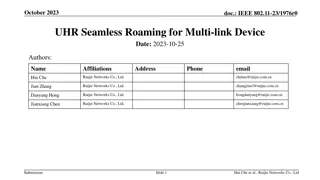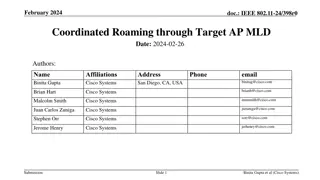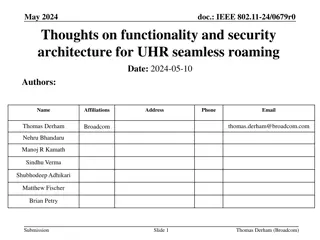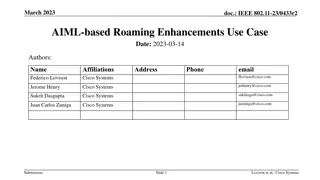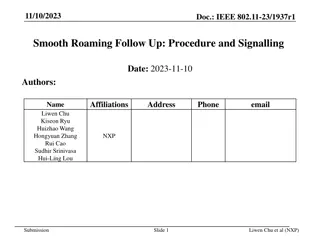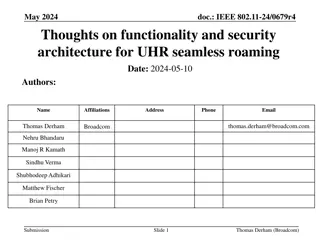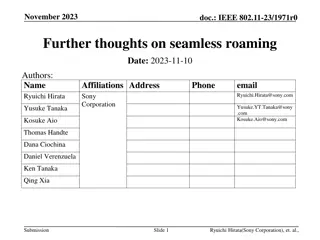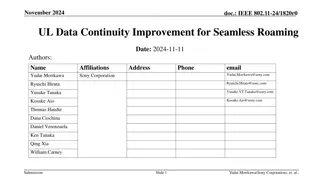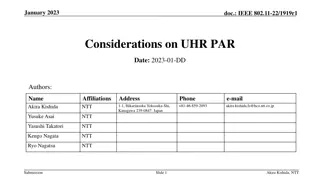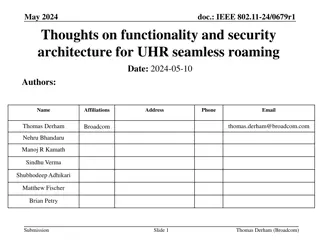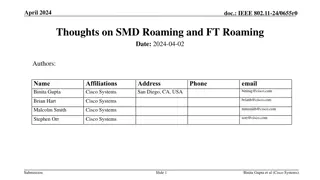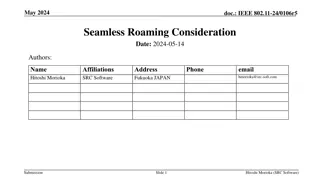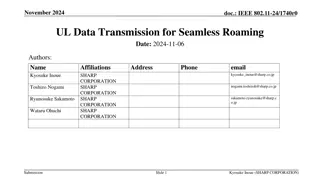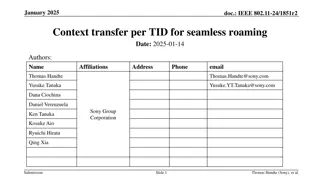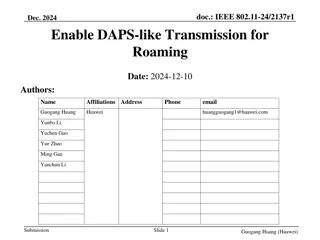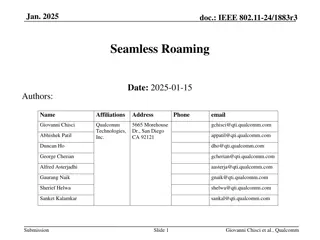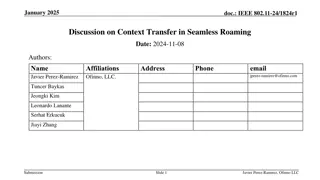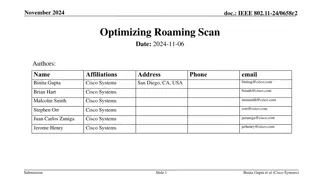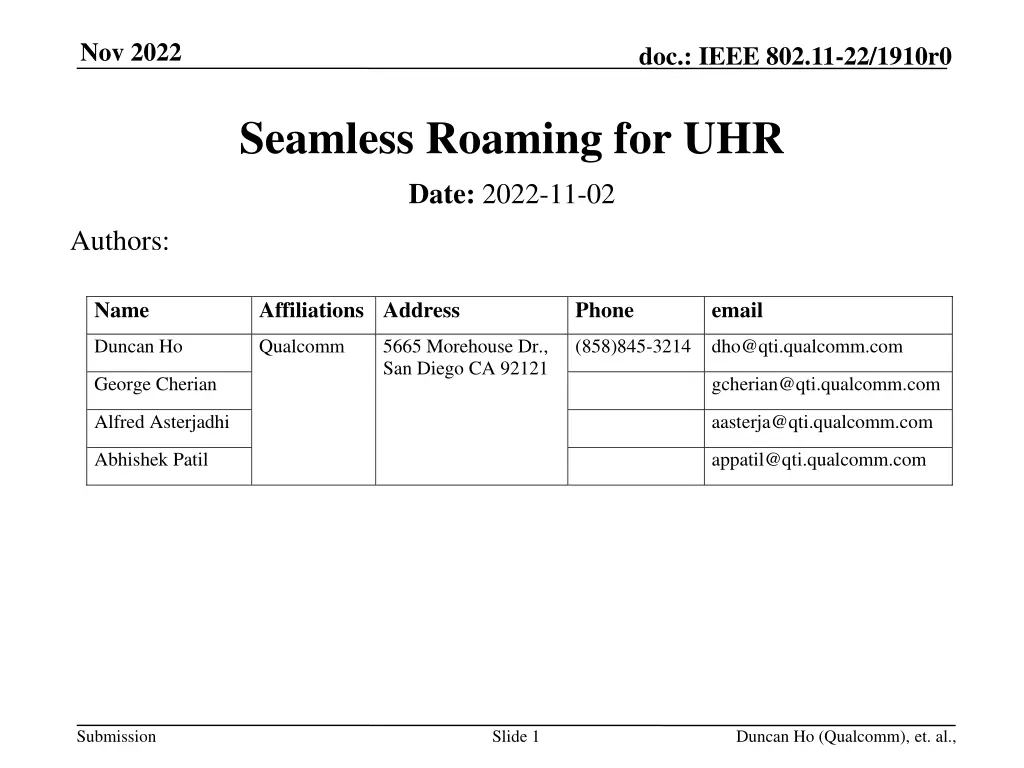
Enhancing Seamless Roaming for Ultra High-Reliability Networks
Explore how IEEE 802.11-22/1910r0 aims to improve mobility support for Ultra High-Reliability networks, focusing on reducing latency and interruptions during handovers. Considerations for a solution include simplicity, flexibility, and scalability to cater to various use cases. An example solution involves leveraging the 11be MLO framework for smoother AP transitions.
Download Presentation

Please find below an Image/Link to download the presentation.
The content on the website is provided AS IS for your information and personal use only. It may not be sold, licensed, or shared on other websites without obtaining consent from the author. If you encounter any issues during the download, it is possible that the publisher has removed the file from their server.
You are allowed to download the files provided on this website for personal or commercial use, subject to the condition that they are used lawfully. All files are the property of their respective owners.
The content on the website is provided AS IS for your information and personal use only. It may not be sold, licensed, or shared on other websites without obtaining consent from the author.
E N D
Presentation Transcript
Nov 2022 doc.: IEEE 802.11-22/1910r0 Seamless Roaming for UHR Date: 2022-11-02 Authors: Name Affiliations Address Phone email Duncan Ho Qualcomm 5665 Morehouse Dr., San Diego CA 92121 (858)845-3214 dho@qti.qualcomm.com George Cherian gcherian@qti.qualcomm.com Alfred Asterjadhi aasterja@qti.qualcomm.com Abhishek Patil appatil@qti.qualcomm.com Submission Slide 1 Duncan Ho (Qualcomm), et. al.,
Nov 2022 doc.: IEEE 802.11-22/1910r0 Problem Statement UHR is aiming for providing better support for applications that require low-latency with high reliability. One area to enhance is mobility support Currently, when the STA roams between multiple APs, the STA needs to re-associate with the target AP and perform 4-way handshake, typically taking 10s of ms The network needs to switch the data path in a break- before-make manner, which creates data interruption and extra delay during handover Submission Slide 2 Duncan Ho (Qualcomm), et. al.,
Nov 2022 doc.: IEEE 802.11-22/1910r0 Current Roaming When the link with AP1 deteriorates and the signal with AP2 grows stronger, the STA roams to AP2 (another case is network-directed roaming using the BSS Transition Mgmt to trigger roaming) The STA performs: Reassociation Security BA sessions re-establishment, etc. The network performs: Switching the data path between the gateway and the AP from AP1 to AP2 The above steps create a delay of 10s of ms Backhaul AP 1 AP 2 STA STA Submission Slide 3 Duncan Ho (Qualcomm), et. al.,
Nov 2022 doc.: IEEE 802.11-22/1910r0 Considerations of Solution Should be simple E.g., Rely on existing frameworks as much as possible Should be flexible To cover different use cases such as home, enterprise, warehouse, etc. Should be scalable To support mobility within a network consisting of large number of APs Submission Slide 4 Duncan Ho (Qualcomm), et. al.,
Nov 2022 doc.: IEEE 802.11-22/1910r0 An Example Solution The 11be MLO framework already allows a non-AP MLD to switch links with minimal signaling overhead and delay E.g., by making the non-collocated APs as affiliated APs of a single AP MLD (see next slide) This approach would enable seamless transition to another AP with no (or minimal) communication interruption by allowing make-before-break data path switch Submission Slide 5 Duncan Ho (Qualcomm), et. al.,
Nov 2022 doc.: IEEE 802.11-22/1910r0 Example Topology Reuse MLO architecture, allowing non-collocated APs to be affiliated with the AP MLD AP MLD (logical entity, physically could be co-located with any of theAP below for each client) Data path Router Affiliated APs (non-collocated) AP3 APn AP1 AP2 STAx STAy Note: SN/PN assignment, encryption are still performed at each AP inline with the existing MLO architecture Submission Slide 6 Duncan Ho, Qualcomm Incorporated
Nov 2022 doc.: IEEE 802.11-22/1910r0 Transition Steps 1. Before transition STA is active with AP1 Data path is routed to AP1 AP1 hosts MLD context for the client 2. During transition STA is active with both AP1 and AP2 AP1 duplicates/forwards packets to AP2 (optional) Both AP1 & AP2 sends packets to client independently 3. After transition STA is no longer active with AP1 Data path re-routed to AP2 AP2 keeps the MLD context for the client AP MLD (logical entity) 3 Router Data path 1 2 Affiliated APs AP 2 AP 1 (non-collocated) 2 STAx STAx MLD Association (auth, assoc., BA context etc.) is maintained during transition from AP1 to AP2 Submission Slide 7 Duncan Ho, Qualcomm Incorporated
Nov 2022 doc.: IEEE 802.11-22/1910r0 Conclusion We introduced the problems of roaming and presented a simple, flexible, and scalable example solution Submission Slide 8 Duncan Ho (Qualcomm), et. al.,

